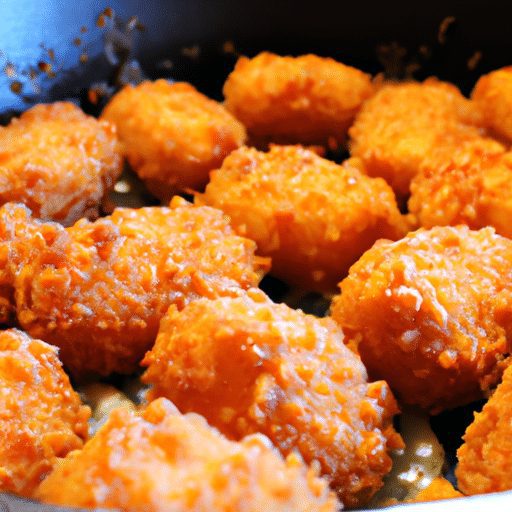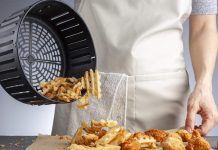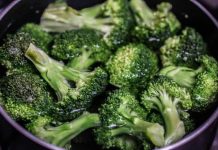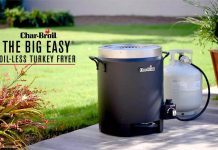Looking to revolutionize your cooking experience? Look no further than the air fryer. In this comprehensive guide, we will take you through the ins and outs of utilizing an air fryer to its fullest potential. From understanding its functions to mastering essential tips and tricks, we’ve got you covered. Get ready to embark on a culinary journey that will not only enhance your meals but also leave your taste buds wanting more. So, fasten your seatbelts and prepare to elevate your cooking skills with the ultimate beginner’s guide to using an air fryer.
Choosing the Right Air Fryer
When it comes to choosing the right air fryer, there are a few factors to consider. First and foremost, it’s important to think about the capacity of the air fryer. If you have a large household or regularly cook for a crowd, you’ll want to invest in a larger air fryer that can accommodate more food at once. On the other hand, if you’re cooking for just yourself or a small family, a smaller capacity air fryer may be more than sufficient.
In addition to capacity, it’s also important to check the features of the air fryer. Some air fryers come with additional features such as a built-in rotisserie or a dehydration function. These extra features can be a great bonus if you enjoy experimenting with different cooking techniques or want to mix up your air frying routine.
Another important aspect of choosing the right air fryer is reading customer reviews. Hearing from other consumers who have used the air fryer can provide valuable insights into its performance, reliability, and overall customer satisfaction. Take the time to read through different reviews to get a sense of how the air fryer performs in real-life situations.
Setting Up Your Air Fryer
Once you’ve chosen the perfect air fryer for your needs, it’s time to set it up and get it ready for use. The first step is unboxing the air fryer. Carefully remove all the packaging materials and make sure to discard them properly. Take a moment to familiarize yourself with all the parts and accessories that come with the air fryer. This will make the setup process much easier.
After unboxing, it’s important to clean and prepare the air fryer before its first use. Most air fryers come with a removable basket and tray, which should be washed with warm soapy water. Make sure to dry them thoroughly before placing them back into the air fryer. Additionally, wipe down the exterior of the air fryer to remove any dust or residue that may have accumulated during shipping.
Understanding the controls of your air fryer is also essential for successful cooking. Familiarize yourself with the different buttons and settings on the control panel. Each air fryer may have slightly different controls, so refer to the instruction manual for specific information. Understanding how to adjust temperature, set timer, and select different cooking modes will ensure that you have a seamless cooking experience.
Preheating the Air Fryer
One important step that should not be overlooked when using an air fryer is preheating. Preheating allows the air fryer to reach the desired cooking temperature before you start cooking your food. This step is essential for achieving crispy and evenly cooked results.
Preheating an air fryer is important because it helps to remove any excess moisture from the heating element and ensures that the food is cooked at the right temperature from the start. It reduces the risk of undercooked food and also helps to enhance the taste and texture of the final dish.
To preheat your air fryer, simply set the desired temperature and let it run for a few minutes. Most air fryers have a preheat setting, which makes this process even easier. Once the air fryer reaches the desired temperature, you can start cooking with confidence, knowing that your food will be cooked to perfection.
Understanding Cooking Temperatures
When it comes to using an air fryer, understanding cooking temperatures is crucial. Different foods require different temperatures to achieve optimal results. Most air fryers come with a temperature range of 180°F to 400°F, which allows for versatile cooking options.
Adjusting the cooking temperatures is relatively simple. Most air fryers have buttons or knobs that allow you to set the desired temperature. Some even have preset cooking options for popular dishes, making it even easier to achieve the perfect temperature for your specific needs.
It’s important to note that cooking times may vary depending on the specific air fryer model and the quantity of food being cooked. Experimentation and a bit of trial and error will help you determine the ideal cooking times for your favorite recipes.
How to Use the Air Fryer
Using an air fryer is relatively straightforward, but it’s always helpful to have a step-by-step guide to ensure success in the kitchen. Here’s a simple guide to get you started:
- Preheat the air fryer by setting the desired temperature and allowing it to run for a few minutes.
- Prepare the food by seasoning it as desired and patting it dry to ensure crispiness.
- Place the food in the air fryer basket, making sure not to overcrowd it. Leave enough space for the hot air to circulate around the food.
- Set the cooking time and temperature based on the recipe or desired crispness level.
- Start the cooking process by pressing the start button or turning the knob. Many air fryers also have preset cooking programs for popular dishes.
- During cooking, it’s important to shake the basket every now and then to ensure that the food is evenly cooked on all sides.
- Once the cooking time is complete, remove the food from the air fryer using tongs or a spatula. Be careful as the air fryer and food will be hot.
- Let the food rest for a few minutes before serving to allow it to cool slightly and for flavors to settle.
Tips for Cooking Different Foods
One of the great benefits of an air fryer is its versatility in cooking a wide range of foods. Here are some tips for cooking common foods:
- For crispy French fries, soak them in cold water for 30 minutes before air frying. This helps to remove excess starch and results in a crispier texture.
- To achieve juicy and flavorful chicken, marinate it in your favorite seasoning before air frying. This allows the flavors to penetrate the meat.
- When cooking vegetables, lightly coat them in oil to help enhance their natural flavors and prevent them from drying out.
- For baked goods, such as muffins or cookies, preheat the air fryer and use a baking accessory or a ramekin to create individual portions.
Exploring Different Cooking Techniques
In addition to air frying, your air fryer can also be used for other cooking techniques such as baking, grilling, and roasting. Here’s how you can explore these techniques:
- For baking, use a baking accessory or a heatproof dish and follow the recipe as usual. Keep in mind that the cooking time may be slightly shorter compared to a conventional oven.
- To grill in your air fryer, use the grill pan accessory or simply place the food directly on the mesh bottom of the air fryer basket. This allows the excess fat to drip away, resulting in healthier grilled dishes.
- Roasting in an air fryer is similar to air frying, but with a longer cooking time. Use the roasting function or adjust the temperature and cooking time based on the specific recipe.
Cooking Times and Recommendations
Determining the cooking times for different foods can be a bit of a learning curve when using an air fryer. Here are some general guidelines to help you get started:
- Frozen fries: 10-15 minutes at 400°F.
- Chicken wings: 20-25 minutes at 400°F, flipping halfway through.
- Salmon fillets: 8-12 minutes at 400°F, depending on thickness.
- Vegetables: 8-12 minutes at 375°F, shaking the basket halfway through.
It’s important to note that these are just general recommendations and cooking times may vary depending on the specific air fryer model, food quantity, and personal preference for doneness. It’s always a good idea to check the food for doneness and adjust the cooking time if needed.
Using Accessories with Your Air Fryer
Accessories can greatly expand the versatility of your air fryer and open up a whole world of cooking possibilities. Here are some important considerations:
Understanding different air fryer accessories is essential for selecting the right ones for your needs. Accessories such as a grill pan, baking accessory, or even a pizza stone can help you achieve specific cooking results.
Recommended accessories for an air fryer include:
- Grill pan: Perfect for grilling burgers, steaks, or even vegetables.
- Baking accessory: Great for making muffins, cookies, or small cakes.
- Skewer racks: Ideal for making kabobs or kebabs.
- Pizza stone: Helps to achieve a crispy crust when making homemade pizza.
It’s important to follow the manufacturer’s instructions when using accessories with your air fryer. Different accessories may require different cooking times and temperature adjustments. Experimentation and practice will help you become more comfortable using these accessories.
Cleaning and Maintenance
Proper cleaning and maintenance of your air fryer are essential for its longevity and optimal performance. Here are some important cleaning tips to keep in mind:
Cleaning the air fryer basket: Most air fryers have a removable basket that should be cleaned after each use. To clean the basket, simply remove it from the air fryer, wash it with warm soapy water, and use a non-abrasive sponge or brush to remove any food residues. Make sure to thoroughly dry the basket before placing it back into the air fryer.
Cleaning the exterior: Wipe down the exterior of the air fryer with a damp cloth to remove any dust or residue. Avoid using abrasive cleaners or scrubbing pads, as they may damage the surface of the air fryer.
Regular maintenance tips: It’s a good idea to periodically check the heating element and fan for any debris or buildup. Use a soft brush or a toothbrush to gently remove any debris. If your air fryer has a non-stick coating, avoid using metal utensils that can scratch the surface. Refer to the manufacturer’s instructions for specific maintenance recommendations for your air fryer model.
Troubleshooting and Common Issues
Even the best air fryers can encounter some common issues. Here’s a troubleshooting guide to help you address any problems:
-
Problem: Food is not crispy enough. Solution: Make sure the food is properly dried before placing it in the air fryer. Shake the basket during cooking to ensure even crisping. Increase the cooking time if needed.
-
Problem: Food is overcooked. Solution: Reduce the cooking time for future use. Keep an eye on the food and check for doneness before the recommended cooking time is complete.
-
Problem: Air fryer is not turning on. Solution: Check the power source and make sure it’s properly plugged in. If the power source is fine, contact customer support for further assistance.
-
Problem: Smoke is coming out of the air fryer. Solution: Check if any excess oil or grease has accumulated in the bottom of the air fryer. Make sure to clean the air fryer thoroughly to prevent smoke.
If you encounter any other issues or have specific questions about your air fryer, refer to the instruction manual or contact the manufacturer’s customer support for assistance.
Using an air fryer can revolutionize your cooking experience and help you create delicious and healthier meals. By choosing the right air fryer, understanding how to set it up, preheat it, and use it properly, you’ll be well on your way to enjoying all the benefits of air frying. With a little practice and experimentation, you’ll become a pro at cooking a variety of foods and exploring different cooking techniques. Happy air frying!































